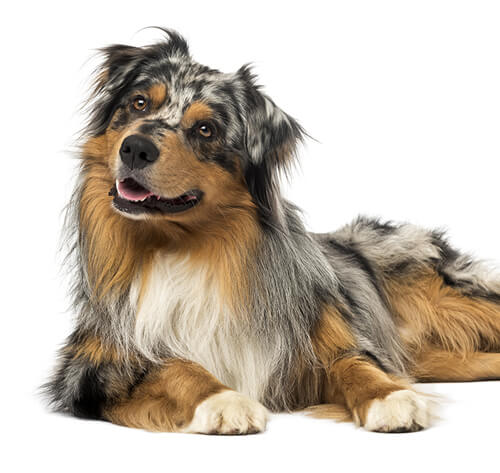
Despite his name, the Australian Shepherd developed in the Pyrenees Mountains. This intelligent, active and good-natured breed is a skilled livestock herder and all-purpose farm and ranch dog. Aussies can be reserved with strangers but are true people dogs that want to be near their family. The breed requires daily vigorous exercise and a sense of purpose. The Aussie’s thick, weather-resistant coat requires weekly brushing.
DID YOU KNOW? The Australian Shepherd derived his name from his association with the Basque Shepherd Dogs that came to the U.S. from Australia in the 1800s. As Australian Shepherds age, their colouring darkens and becomes more “pure”.
ALSO KNOWN AS: Aussie, Little Blue Dog
The need-to-know
- Dog suitable for owners with some experience
- Some training required
- Enjoys vigorous walks
- Enjoys walking more than two hours a day
- Medium dog
- Some drool
- Requires grooming every other day
- Non hypoallergenic breed
- Very vocal dog
- Guard dog. Barks and alerts
- May require training to live with other pets
- May require training to live with kids
Personality

This dog has strong herding instincts and loves to be part of family life, thriving on the companionship of his owners. They can be initially reserved with new people so early socialisation is essential. Ongoing training and a combination of physical and mental stimulation is also important to satisfy his considerable intelligence and energy.
History and Origins

Surprisingly, the Australian Shepherd dog breed is actually American! Shepherds from the Basque region of the Pyrenees took small 'blue' dogs to work in the U.S. in the late 1800s and early 1900s to work with sheep. The Australian part of the name comes from the sheep that they worked with that were imported from Australia. Another theory suggests that the dogs immigrated first to Australia and then to the U.S. When they first arrived in the south-western United States in the late 1800s, the dogs were initially allowed to interbreed with other shepherd dogs, to enhance working ability. A breed club was established in the U.S. in 1957.
Nutrition and Feeding

Your dog's diet needs to have the right balance of all the main nutrient groups including a constant supply of fresh water. It's also important to conduct regular body condition scores to ensure you keep your dog in ideal shape and remember to feed him at least twice daily and in accordance with the feeding guidelines of his particular food.
Exercise

This dog needs at least two hours a day. Many Australian Shepherd dogs perform to a high standard in the dog sports (agility, heelwork to music, obedience and flyball), where they can use their physical and mental energy.
Other Information

Health and common issues
The Australian Shepherd dog is generally a very healthy breed. However as with many breeds, they can suffer from various hereditary eye disorders, and hip dysplasia (a condition that can lead to mobility problems). Eye testing and hip scoring of dogs prior to breeding is therefore important.
Best family dog breeds
While many dogs are traditionally thought of as being good with children , all dogs and children need to be taught to get on with and respect each other, and be safe together. Even so, dogs and young children should never be left alone together and adults should supervise all interactions between them.